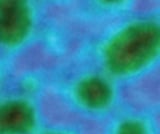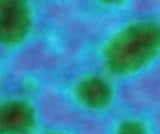
Although not visible at this magnification, the high resolution image in the open access research publication clearly shows the gold atoms, with a spacing of 0.236 nm between atomic planes.
In his famous visionary 1959 talk in which he described molecular machines building with atomic precision, Feynman suggested that if physicists wanted to help biologists, they should improve the electron microscope by a hundred times to see individual atoms. Many improvements have been made over the years, such as aberration-correcting electron lenses, but a recent contribution from the University of Sheffield has succeeded in showing for the first time that it is possible to recover the complex exit wave from a diffraction image at atomic resolution, over a wide field of view, and using low-energy electrons. A hat tip to ScienceDaily for reprinting this University of Sheffield news release “Scientists revolutionise electron microscope“:
For over 70 years, transmission electron microscopy (TEM), which `looks through´ an object to see atomic features within it, has been constrained by the relatively poor lenses which are used to form the image.
The new method, called electron ptychography, dispenses with the lens and instead forms the image by reconstructing the scattered electron-waves after they have passed through the sample using computers.
Scientists involved in the scheme consider their findings to be a `first step´ in a `completely new epoch of electron imaging´. The process has no fundamental experimental boundaries and it is thought it will transform sub-atomic scale transmission imaging.
Project leader Professor John Rodenburg, of the University of Sheffield´s Department of Electronic and Electrical Engineering, said: “To understand how material behaves, we need to know exactly where the atoms are. This approach will enable us to look at how atoms sit next to one another in a solid object as if we´re holding them in our hands.
“We´ve shown we can improve upon the resolution limit of an electron lens by a factor of five. An extension of the same method should reach the highest resolution transmission image ever obtained; about one tenth of an atomic diameter. No longer does TEM have to be bound by the paradigm of the lens, its Achilles´ heel since its invention in 1933.” …
Professor Rodenburg added: “We measure diffraction patterns rather than images. What we record is equivalent to the strength of the electron, X-ray or light waves which have been scattered by the object – this is called their intensity. However, to make an image, we need to know when the peaks and troughs of the waves arrive at the detector – this is called their phase.
“The key breakthrough has been to develop a way to calculate the phase of the waves from their intensity alone. Once we have this, we can work out backwards what the waves were scattered from: that is, we can form an aberration-free image of the object, which is much better than can be achieved with a normal lens.
“A typical electron or X-ray microscope image is about one hundred times more blurred than the theoretical limit defined by the wavelength. In this project, the eventual aim is to get the best-ever pictures of individual atoms in any structure seen within a three-dimensional object.” …
The research was published in Nature Communications as an open access article “Ptychographic electron microscopy using high-angle dark-field scattering for sub-nanometre resolution imaging“. Although the image in the press release (above) of the gold particles is too low a magnification to see the rows of atoms, the high resolution version of the image in the research paper clearly shows the gold atoms, with a spacing of 0.236 nm between atomic planes. Additional information is available on the authors’ project web site “Welcome to the ΠΦ project“.
—James Lewis


